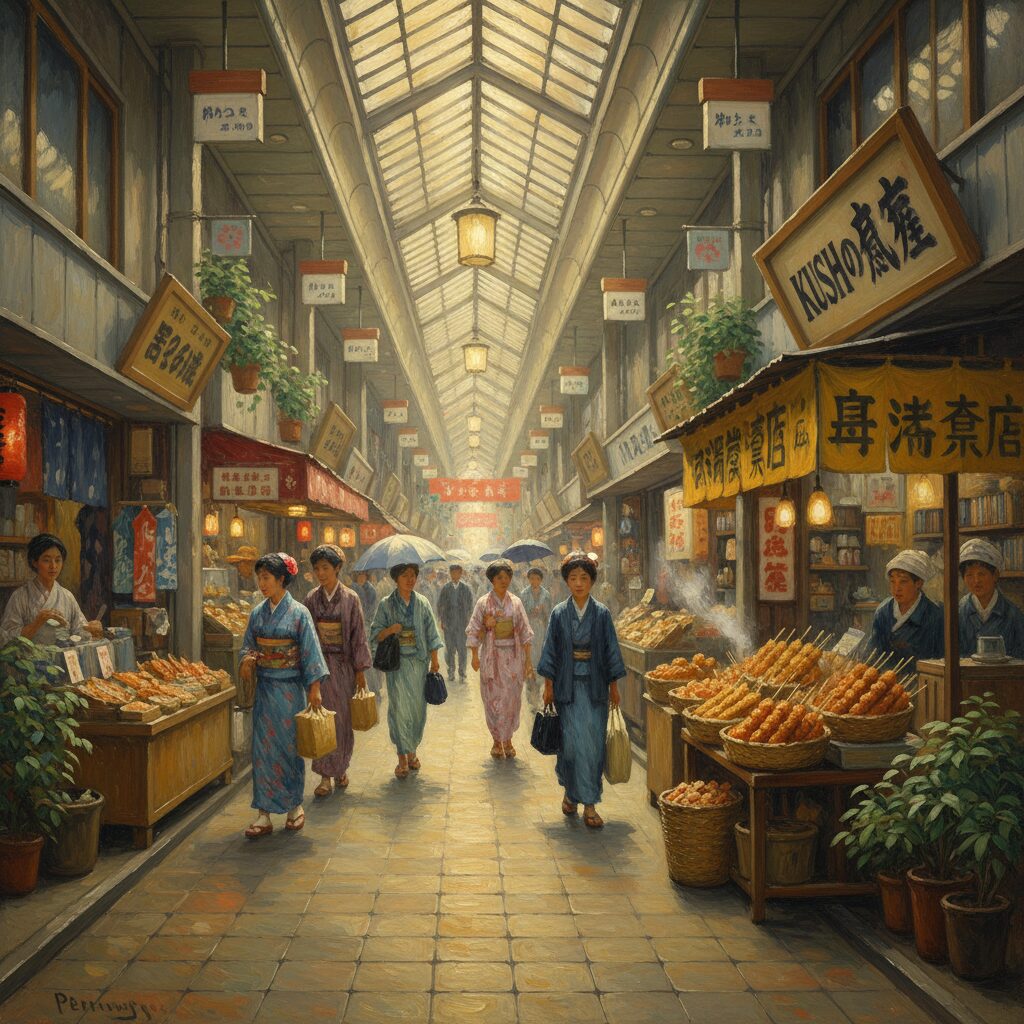Step off the subway at Komagawa-Nakano, and the air itself seems to shift. The polished hum of central Osaka, with its gleaming towers and crisscrossing train lines, fades into a different kind of rhythm. It’s a cadence of bicycle bells, the friendly chatter of neighbors, and the irresistible sizzle of something delicious being fried. This is the gateway to the Komagawa Shopping Street, a sprawling, covered arcade—a shotengai—that acts as the vibrant, beating heart of this southern Osaka neighborhood. Forget the dazzling lights of Dotonbori for a moment; this is where the city’s soul comes for lunch. Here, life isn’t a spectacle for tourists, but a daily, unscripted performance of community and commerce. Our mission today is a simple yet profoundly satisfying one: to uncover the absolute best in takeout kushikatsu, the deep-fried skewers that are an Osaka culinary cornerstone. We’re bypassing the formal restaurants and heading straight to the source—the local butcher shops and delis where these golden treasures are crafted not for a menu, but for the dinner tables of the people who call this place home. This is a journey into the flavor of everyday Osaka, a taste of authenticity you can hold in your hand.
After savoring these authentic local flavors, you might also enjoy exploring other unique destinations in the region, such as the beautiful Sennan Long Park coastline for sunset views and ocean adventures.
The Living Arcade: Unpacking the Atmosphere of a True Shotengai

The moment you pass beneath the arched entrance of the Komagawa Shopping Street, you’re immediately immersed. It’s a world unto itself—a covered expanse stretching over 700 meters, with smaller branches leading off, each offering its own unique charm. The light filters softly through the translucent panels of the arcade roof, casting a timeless glow that feels unchanged from noon to late afternoon. This is a space designed for people, not vehicles. The lanes bustle with pedestrians of all ages: mothers with children, elderly couples running errands, and local workers grabbing quick meals. The soundscape is a vibrant blend of cheerful vendor calls—“Irasshaimase!”—the hum of bicycle wheels on smooth pavement, and the sizzle and steam rising from numerous small shops. There’s a lively energy here, a steady current of life that is both purposeful and relaxed. Unlike the frenetic pace of downtown areas, this place moves to the steady, dependable rhythm of a community hub. Coming from a background where bustling markets shape daily life, I see a striking similarity here. Like the lively street markets of Beijing or Taipei, the shotengai blends commerce with social connection seamlessly. Yet, there is a distinctly Japanese sense of order and cleanliness that harmonizes with the friendly bustle. It’s a place where every shopkeeper knows their regular customers, where conversations flow freely over counters, and where the simple act of buying groceries becomes a shared moment of human connection. You can sense the history beneath your feet in the worn tiles and glimpse the future in the modern touches of newer shops nestled among long-established ones. This isn’t merely a shopping street; it’s the neighborhood’s living room, pantry, and main artery all rolled into one.
The Golden Rule: Why Butcher Shop Kushikatsu Reigns Supreme
In Osaka, kushikatsu is a cultural staple. These skewers of meat, seafood, and vegetables, coated in a light layer of panko breadcrumbs and fried to a perfect golden crisp, epitomize the city’s hearty and straightforward culinary tradition. Many visitors are guided to the lively Shinsekai district, where dedicated eateries serve platters of skewers alongside iconic communal dipping sauce pots, accompanied by the strict “no double-dipping” rule. That experience is wonderful, a must-do for any food enthusiast in Osaka. However, the true local secret, whispered among residents, lies in a different approach. It involves obtaining your kushikatsu not from a restaurant, but directly from the artisans most familiar with the ingredients: the butchers (oniku-ya) and delicatessen owners (osozai-ya). This is where the real magic unfolds. At a butcher shop, kushikatsu isn’t merely an item on the menu; it’s a proud extension of their core craft. The beef skewer (gyu-kushi) uses the same cuts sold for dinner steaks, and the pork loin (ton-katsu) skewers are miniature versions of the premium cutlets prepared for families. The link between raw ingredient and final dish is immediate and transparent. You’re tasting the butcher’s expertise in its purest form. This practice aligns with a fundamental Japanese food philosophy of minimizing waste and maximizing flavor, known as mottainai. Smaller, irregular cuts of excellent meat, unsuitable for steaks, are transformed into these tasty and affordable snacks. It’s a brilliant and delicious example of culinary efficiency. Delis, meanwhile, provide a different but equally appealing experience. These shops are saviors for the Japanese home cook, offering an impressive variety of prepared side dishes, from simmered vegetables to fresh salads. Their kushikatsu selection is often more diverse and imaginative, reflecting a desire to offer variety for the everyday dinner table. Here, you’ll find skewers of lotus root, sweet pumpkin, and creamy croquettes alongside the meatier classics. Purchasing from these shops allows you to engage in the local food cycle, eating as the locals do—grabbing a few skewers as a hearty snack, a simple lunch, or a flavorful addition to the evening meal. It’s a more personal, direct, and arguably more delicious way to enjoy Osaka’s favorite fried treat.
A Culinary Safari: Stalking the Wild Skewer
Strolling through Komagawa is a feast for the senses, and the quest for the perfect kushikatsu becomes an exhilarating adventure. You don’t need a map—just follow your nose and your eyes. The shops gradually reveal themselves as you wander, each boasting its own character and specialties.
The Butcher’s Pride: The Oniku-ya
You’ll often catch the scent of the butcher shop before seeing it—a complex, comforting mix of fresh raw meat intertwined with the clean, hot aroma of frying oil. These establishments tend to be no-frills. The storefront might be simple, with a refrigerated case showcasing marbled beef and pristine pork chops on one side, and a smaller, heated glass case on the other, glowing with a golden array of freshly fried items. Inside this case, you’ll find the classics. The star is almost always the gyu-kushi, a skewer of tender, flavorful beef, typically lightly seasoned to highlight the meat’s quality. Beside it, you might spot skewers of juicy pork, chicken, and even beef liver (rebā), a local favorite. The owner, often a seasoned expert with decades of experience, works with focused grace, knowing the exact oil temperature and the precise moment when a skewer is perfectly cooked—crispy on the outside, juicy within. There’s a straightforward honesty to this transaction. You’re purchasing a product born from skill, a simple pleasure honed through years of practice. Pointing at your selections is perfectly acceptable, and watching your chosen skewers being taken from the case and wrapped in simple paper is part of the charm.
The Deli’s Delight: The Osozai-ya
The osozai-ya offers a different kind of visual feast. These delis are a kaleidoscope of colors and textures. Their display cases are filled not only with fried items but also with a wide array of home-style Japanese dishes: shiny seaweed salads, deep-orange simmered pumpkin, savory potato salads, and perfectly rolled tamagoyaki. It’s a snapshot of a traditional Japanese meal. Within this vibrant mosaic, you’ll find the kushikatsu section. The variety is often astonishing. Alongside beef and pork, you’ll discover skewers of onion (tamanegi), tender and sweet when fried; green pepper (pīman); shiitake mushrooms; and quail eggs (uzura). My personal favorites tend to be the non-meat options, like lotus root (renkon), which keeps a lovely, earthy crunch, and sweet potato (satsumaimo), becoming creamy and almost dessert-like. These delis cater to the neighborhood’s tastes, providing components for a balanced and intriguing meal. Their kushikatsu reflects this, offering a broader palette of flavors and textures. It feels like stepping into a local kitchen, a place that understands the need for both comfort and variety in everyday food.
The Art of Enjoying Your Takeout Treasure

After gathering your collection of golden skewers from various shops, the next step is figuring out the best way to enjoy them. This is when you truly embrace the local lifestyle. The first rule is to come prepared. Although Japan is becoming more credit-card friendly, these small, family-run stores in a local shotengai often only accept cash. Having small bills and coins ready ensures a smooth transaction and is much appreciated. When ordering, simply point and indicate the number of skewers you want. A friendly “Kore wo ippon, kudasai” (“One of this, please”) will bring a warm smile. Now, onto the crucial part: eating. While eating and walking (aruki-gui) is generally frowned upon in Japan, the rules tend to be more relaxed inside the lively, food-focused shotengai. The most respectful way is to find a small bench or a designated rest area within the arcade to enjoy your food. This lets you savor the flavors without disturbing other shoppers. An even better option, and my personal favorite, is to take your haul for a short walk to a nearby park, such as Komagawa Park. There, you can sit down, unwrap your paper packages, and have a proper picnic. This turns a simple snack into a memorable meal, letting you enjoy the fresh air while watching the world go by. A quick note on sauce: unlike restaurants, takeout kushikatsu may or may not come with sauce. Some shops will ask if you want it and provide a small packet of the sweet and tangy dipping sauce. Others serve them plain, assuming you’re taking them home. Don’t be disappointed if there’s no sauce. A truly excellent skewer, fresh from the fryer, is wonderful on its own, allowing you to fully appreciate the flavor of the main ingredient and the crispiness of the panko coating. It’s a pure, unadulterated delight.
Beyond the Skewer: Exploring Komagawa’s Other Charms
While the pursuit of kushikatsu is a worthy endeavor, it would be a missed opportunity to visit Komagawa Shopping Street without exploring its other culinary and cultural delights. The arcade serves as a microcosm of Osaka‘s vibrant food scene. Here, you’ll find stalls offering plump, piping-hot takoyaki (octopus balls), their surfaces glistening with savory sauce and bonito flakes fluttering in the steam. Other shops specialize in okonomiyaki, the beloved savory pancake, often sold as a satisfying slice to take away. For those with a sweet tooth, traditional Japanese sweet shops (wagashi-ya) present beautifully crafted mochi and seasonal confections. It’s a wonderful chance to witness how deeply food and seasonality are woven into Japanese culture. But the street is more than just food—it’s a living, working community. Peek inside the shops selling everyday essentials: a tiny stationery store bursting with colorful pens and notebooks, a hardware shop stocked with tools for home repairs, a local pharmacy where the pharmacist greets customers by name, and small clothing boutiques offering practical, comfortable apparel. You’ll also see vendors selling fresh tofu, arranging gleaming local produce, and fishmongers displaying the day’s catch on beds of ice. Taking the time to observe these interactions gives a richer understanding of life in an Osaka neighborhood. This context enhances the food experience, linking the kushikatsu in your hand to the broader community that created it. It serves as a reminder that food is never just fuel; it is culture, community, and connection.
A Guide for the Intrepid Food Explorer

Finding your way to this local paradise is surprisingly straightforward, making it a simple and rewarding detour from the main tourist route. Your main entry point is Komagawa-Nakano Station, conveniently situated on the purple Tanimachi Line of the Osaka Metro. It’s a direct ride from major hubs like Higashi-Umeda and Tennoji. Alternatively, Harinakano Station on the Kintetsu Minami Osaka Line is just a short walk away, effectively linking two different rail networks to this lively area. The ideal time to visit is during the day, from late morning to mid-afternoon, approximately between 11:00 AM and 4:00 PM. This is when the street is at its busiest, all the shops are open, and the fryers are working overtime to serve the lunch crowd. While some places remain open later, many smaller, family-run shops start closing as dinner time nears, so visiting during the day allows you to experience the shotengai at its peak. As for what to bring, keep it simple: comfortable walking shoes are essential, as you’ll want to explore the arcade fully. Bring enough cash for your purchases, as it’s still the preferred payment method for many vendors. Carrying a small reusable bag can also be helpful for your treats. My most important tip for first-time visitors is to embrace a spirit of curious wandering. Don’t hesitate to stop, look around, and try things that catch your eye, even if you aren’t sure what they are. The shopkeepers are part of the experience. They may not speak English, but a smile is a universal language. They take pride in their products and are usually delighted to see appreciative customers, whether local or visitors. Set aside any hesitations, point to that intriguing skewer, and prepare for a delightful surprise. This is how you find your new favorite food.
Finding the Soulful Taste of Osaka
A visit to Komagawa Shopping Street is more than just a lunch break; it’s a full immersion. It offers a chance to step into the gentle, steady flow of daily life in Osaka, a city often known for its more flashy and brightly-lit attractions. Here, amid the rhythmic bustle of the arcade, you encounter a different kind of energy—one rooted in community, tradition, and the simple, profound joy of carefully prepared, delicious food. The search for the perfect takeout kushikatsu becomes the key that opens this world. Each skewer, whether a classic beef cutlet from a proud butcher or a creative vegetable combo from a friendly deli, tells a story about the neighborhood. It’s a story of quality ingredients, time-honored techniques, and the vital role these small businesses play in the everyday lives of those they serve. So, when you visit Osaka, by all means, see the famous sights. But then, take a short ride on the Tanimachi Line. Leave the crowds behind and step into the warm, welcoming embrace of Komagawa. Let your senses lead you through the long, covered street. Build your own personal kushikatsu feast, find a quiet spot to savor it, and taste the true, soulful flavor of this remarkable city. It’s a simple adventure, but one that will linger long after the last delicious, crispy bite is gone.


